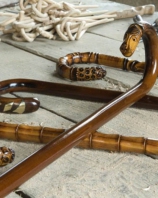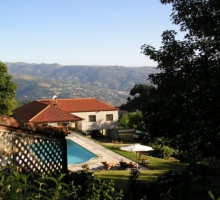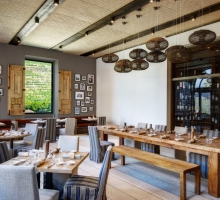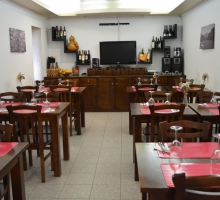The Casa das Bengalas de Gestaçô (Gestaçô Sticks House) is a museum center created in order to preserve the historic memory of a craft with long decades of tradition in the parish and in the county, as well as to value this activity in social terms and to create an exhibition, demonstration and commercialization space.
The space includes a small museum, where it is depicted the history of Bengalas de Gestaçô ((Gestaçô Walking Sticks) and the craftsmen who dedicated themselves to the craft; a local demonstration, equipped as a workshop where visitors can learn about the process of the walking sticks design and production, as well as exhibition and marketing areas.
The first walking sticks workshops appeared in the late XIX century. Alexandre Pinto Ribeiro was the great driving force having installed his workshop there in 1902.
Alexandre Pinto Ribeiro revolutionized the entire process of design and production of the walking sticks and umbrella crooks, introducing a small innovation: the technique of folding. This technique consists in bending the tips of the softened wood strips in boiling water with the aid of a metal bar, allowing a greater saving in terms of raw material and obtaining a higher quality walking stick. From this technical advance, Gestaçô became a reference to the regional level, both in walking sticks production and the umbrella hand, receiving an increasing number of order from Oporto, São João da Madeira and Braga.
With the technique came the creativity to draw the walking sticks which became more beautiful: some with animal heads, some with mother of pearl, silver or gold engravings.But fashion changes and so the walking sticks were no longer part of the male clothing and the umbrella crooks began to be made in plastic, which caused the closure of many workshops in Gestaçô.
The generalization of the “Queima das Fitas” (an every year university festivity) gave a new breath to this office: every year about 30 thousand university students strike with the walking sticks produced in the craft workshops of Gestaçô.
Location: Baião
The space includes a small museum, where it is depicted the history of Bengalas de Gestaçô ((Gestaçô Walking Sticks) and the craftsmen who dedicated themselves to the craft; a local demonstration, equipped as a workshop where visitors can learn about the process of the walking sticks design and production, as well as exhibition and marketing areas.
The first walking sticks workshops appeared in the late XIX century. Alexandre Pinto Ribeiro was the great driving force having installed his workshop there in 1902.
Alexandre Pinto Ribeiro revolutionized the entire process of design and production of the walking sticks and umbrella crooks, introducing a small innovation: the technique of folding. This technique consists in bending the tips of the softened wood strips in boiling water with the aid of a metal bar, allowing a greater saving in terms of raw material and obtaining a higher quality walking stick. From this technical advance, Gestaçô became a reference to the regional level, both in walking sticks production and the umbrella hand, receiving an increasing number of order from Oporto, São João da Madeira and Braga.
With the technique came the creativity to draw the walking sticks which became more beautiful: some with animal heads, some with mother of pearl, silver or gold engravings.But fashion changes and so the walking sticks were no longer part of the male clothing and the umbrella crooks began to be made in plastic, which caused the closure of many workshops in Gestaçô.
The generalization of the “Queima das Fitas” (an every year university festivity) gave a new breath to this office: every year about 30 thousand university students strike with the walking sticks produced in the craft workshops of Gestaçô.
Location: Baião










